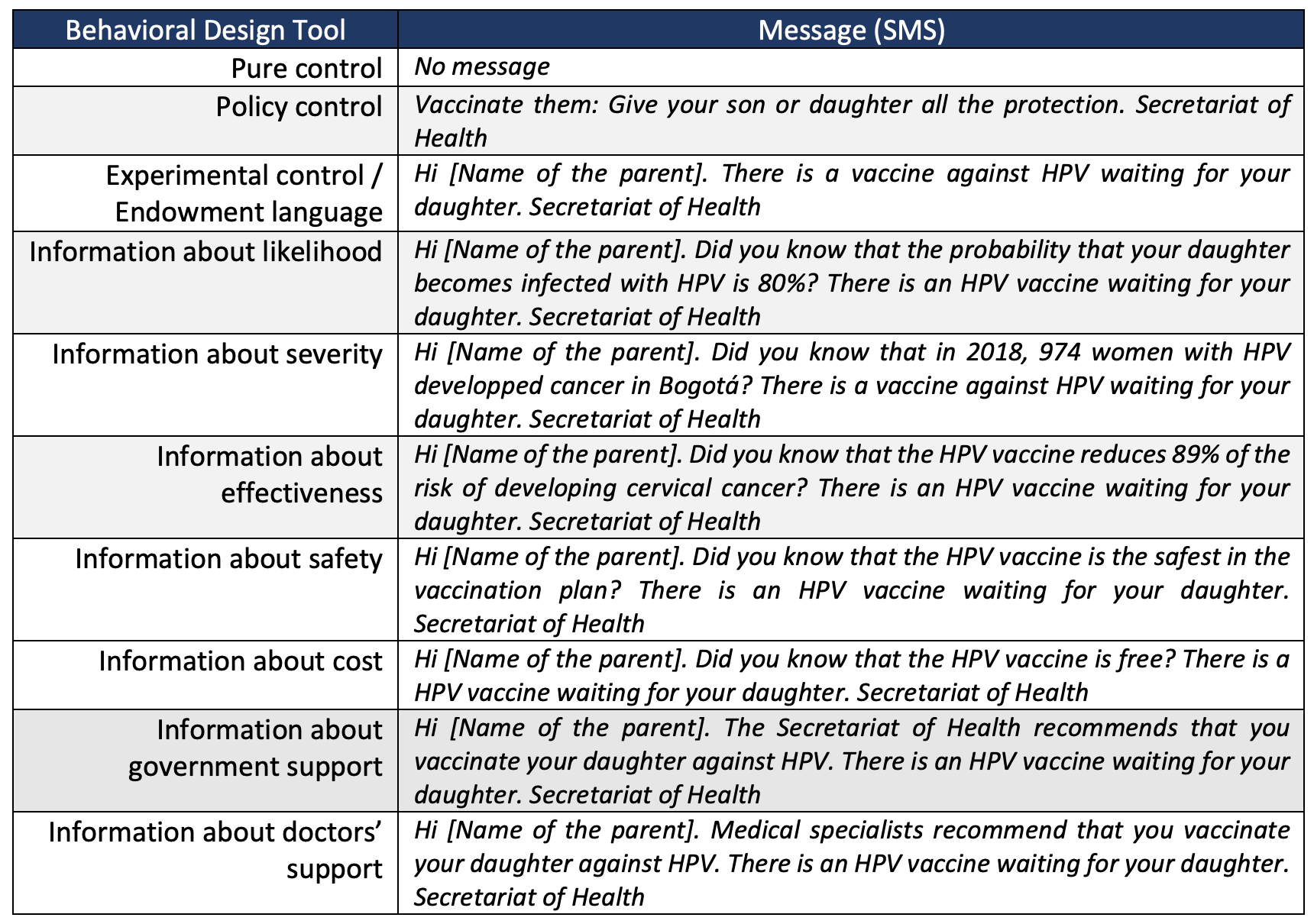Nudging parents with tailored informational SMS can increase HPV vaccinations

Context
According to the Ministry of Health and Social Protection, cervical cancer is the leading cause of death from cancer among women aged 30 to 59 years in Colombia. Unlike many other cancers, this type is mainly caused by a virus: the Human Papilloma Virus (HPV), which can be transmitted through oral, vaginal, or anal sexual contact. The prevalence of HPV in Latin America and the Caribbean is 16%, the second highest in the world after countries in Sub-Saharan Africa (24%). Fortunately, the risk of HPV infection and the risk of developing this type of cancer can be prevented through a vaccine administered free of charge in Colombia to girls and adolescents between the ages of 9 and 17. However, HPV vaccination coverage in Bogotá is lower than expected, and only 6% of 9-year-old girls in 2019 were fully inoculated with two doses of the HPV vaccine.
The Project
To increase the HPV vaccination rate in Bogotá, the Behavioral Economics Group sent text messages with behavioral economics principles to parents of girls between 9 and 17 years, in coordination with the Secretariat of Health of Bogotá, the Ministry of Health of Colombia, the American Cancer Society (ACS), the Liga Colombiana Contra el Cáncer and Universidad del Rosario. The complete intervention targeted a total of 174,181 parents. From that sample, 75% were nudged to vaccinate their daughters for the first time, while the rest were parents of girls and adolescents pending one vaccine who were reminded to complete the entire vaccination scheme of two doses. This project summary presents one out of the six experiments run during the whole project. The intervention took place between October 2021 and December 2021.
Behavioral Barriers:
Salience: Our attention is limited. Therefore, behavioral economics interventions carefully consider the moment when a message is delivered, the location in which it is delivered, and the content it emphasizes. In this context, parents are unsure when they should vaccinate their daughters against HPV and wait for the doctors to recommend vaccination. However, all the doctors interviewed reported limited time during appointments, and more urgent issues took priority over HPV. The absence of discussions and reminders leads parents to assume passive attitudes toward HPV vaccination. In general, there is a lack of moments of reflection, choice, and opportunity to take action on HPV vaccination for girls aged 9-17 in Bogotá.
Mental accounting: Mental accounting is our tendency to mentally sort our money into separate “accounts,” leading us to see money as less fungible than it is and affecting our spending behavior. The concept is usually applied to personal finances, but in this context we apply it to the use of time and activity. In the case of children’s vaccines, although the vaccine is part of the full vaccination scheme, parents do not put the same amount of effort into vaccinating their daughters against HPV as for other vaccines deemed “more essential.” Evidence from our interviews indicates that parents mistakenly view vaccination as no longer a significant priority in children's health considerations after five years of age.
Mistrust: Mistrust occurs when one party is unwilling to rely on the actions of another party in a future situation. Government support for the HPV vaccine has waxed and waned in the past, adding complexity to parents’ decision to vaccinate their daughters. Health professionals believe that a more explicit endorsement from the government would increase trust and make parents more likely to accept the vaccine recommendation. Parents interviewed in the diagnostic phase of our study expressed their desire for the government to take a more explicit stance on their support of HPV vaccinations.
Present bias: Present bias, associated with a preference for instant gratification, is the tendency to opt for a lesser benefit in the short term over a greater benefit in the longer term. Because immunity is not tangible, it is difficult to appreciate the benefits of vaccination in the short term. In addition, there is no immediate consequence for failing to receive the HPV vaccine; this stands in contrast to, for example, the requirement of certain immunizations for children 0-5 years in order to be admitted to school. It thus becomes easy to put off the decision about HPV vaccination to the future.
Behavioral Tools:
Information: Frequently, our target population does not have the information needed to make a decision, and providing the information is sufficient to nudge people into a decision and consequently undertaking a beneficial action. For instance, although the full vaccination scheme of two doses is administered with no cost to families, some parents we interviewed were unsure about the cost of the vaccine for them and mentioned that the cost of the vaccine was preventing them from vaccinating their daughters. In this project, we informed parents that vaccinating their daughters is free.
Framing: The way information is presented can have a big impact on people’s understanding of it, and on the actions they take. For example, highlighting the negative aspect of a decision can cause an option to be perceived as more—or less—attractive. To emphasize the importance of the vaccine, we informed parents about HPV contagion and cervical cancer prevalence, focusing on loss framing to highlight the necessity of the vaccine. Additionally, we varied the way we presented contagion and prevalence information, as well as information on vaccine effectiveness, using percentages, raw numbers, or qualitative terms.
Messenger effect/trust: The source of information is important for people. People assess information differently depending on who sends the message and how much they trust that source. We explicitly stated government support and doctor’s support based on the expressed need for their support in the interviews we conducted.
Intervention Design
The Behavioral Economics Group, in coordination with the Secretariat of Health of Bogotá, the Ministry of Health in Colombia, La Liga Colombiana Contra el Cáncer, the American Cancer Society, and Universidad del Rosario, implemented several SMS experiments designed to increase HPV vaccination rates in Colombia. All the experiments were implemented through a text message campaign (SMS), differing in the behavioral tool used to prepare the message. Our team decided on this channel because the Secretariat of Health of Bogota had already launched several SMS campaigns in the past. In this summary, we will explain one of those experiments based on information that is aimed at changing parents’ beliefs about safety, cost, the effectiveness of HPV vaccine, HPV severity, and government and medical support.
This experiment targeted parents of girls who had never been vaccinated against HPV in the past, and the objective was to help them vaccinate their daughters for the first time. The number of parents who participated in this experiment was around 34,506. Table 1 shows the message by behavioral design tool used to design each message.
Table 1. Message content by behavioral design tool

As Table 1 shows, this experiment included seven treatments designed with informational elements and three control groups. The pure control group did not receive any message. The policy control group received the "business as usual" message that the Secretariat of Health in Bogotá was using in communications with the target population. The experimental control group included fixed elements that were incorporated into every treatment. The fixed elements for this informational experiment were a customized greeting with the parent’s name, the Secretariat of Health’s signature, and endowment language. The latter communicates that there is a vaccine readily available for the person’s daughter, thus presenting the HPV vaccine as something that the person already owns. Therefore, not vaccinating their daughter implies losing something, which the evidence indicates can be a more powerful driver than the possibility of acquiring something that is not yet theirs—so-called loss aversion. Each treatment tested information combined with the fixed elements in the experimental control.
Each behavioral treatment aimed at closing the gap between reality and patterns of erroneous beliefs arising from lack of information. We believe that by resolving doubts about government and doctors’ support, and communicating important factual information about this dangerous virus, parents will be more likely to vaccinate their daughters against HPV.
The experiment consisted of sending a weekly text message to the target population’s parents over eight weeks. The content of the message remained constant. The vaccination records of the Secretariat of Health are updated daily, and our team received them weekly. This allowed us to remove those parents who had already taken action before sending the subsequent message.
Challenges
This project had several challenges:
- Despite our team’s solid credentials, it took considerable effort to create rapport with government employees at the Secretariat of Health. Specifically, the Secretariat of Health’s ethics committee asked us to make significant revisions to our ethics materials, even though the project had already gone through the ethics committee at Universidad del Rosario.
- Related to that, it was not easy or fast to get the data set from the Secretariat of Health's records because it took time to synchronize our team’s needs with the data extraction from administrative records.
- Another obstacle was that the proposed government’s partner agency could not send the text messages, so we had to find an alternative platform to send SMS. We used a platform that we had previously worked with (Altiria), and our team programmed and sent the SMS. The upside is that we gained control over the experiment. However, we lost the opportunity to train government officials on these interventions.
- HPV vaccines ran out after week 4 of our intervention in some vaccination centers. We had to stop sending SMS and helped in the coordination between the Ministry of Health and the Secretariat of Health. They quickly responded, and we were able to resume the experiment after pausing it for ten days.
Results
Results indicate that the SMS intervention increased first-time HPV vaccination rates in Bogotá.
- The most impactful treatment to increase first-time vaccinations was information from doctors’ recommendations. This group had an average vaccination rate of 7.5%, representing a 35% increase compared to the control group (vaccination group average of 5.5%).
- Closely behind was the impact of the message that reinforced government support of the vaccine and provided information on the vaccine’s safety and the severity of HPV. The effects of these treatments are statistically significant compared to the control group average.
- In this experiment, the policy control was not statistically significantly different from the pure control, indicating that general messages, which do not incorporate behaviorally informed insights, are not useful in nudging parents to vaccinate their daughters against HPV.
Figure 1. Information about doctor’s recommendations and reassuring information about government support had the most impact on increasing HPV vaccinations

Policy implications
- We encourage government officials to listen to parents’ concerns and respond in a clear and supportive way if they have the information to solve them. For instance, in Bogotá, many parents were waiting to hear their doctors’ recommendations on whether and when to vaccinate their daughters. Since it is a health recommendation to vaccinate their children at the age of nine, public health officials can easily remind parents to vaccinate their children’s when they turn nine by using doctors’ recommendations as part of that message.
- If the government has not been clear about its stance on public health recommendations, a communications campaign reinforcing its stance—in this case, pro-vaccination—would go a long way in nudging citizens to take action.
- Showing a consistent stance among different stakeholders may reassure individuals about the veracity of the information. In this experiment, the message informing about the doctors’ support had the government’s signature (as one of the fixed elements in all treatments.) It is possible that a message communicating both stakeholders’ support may have enhanced the message to make it the most powerful in this experiment.
